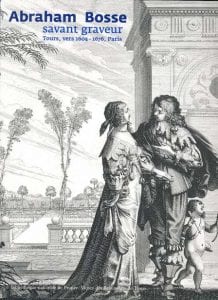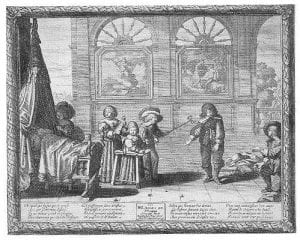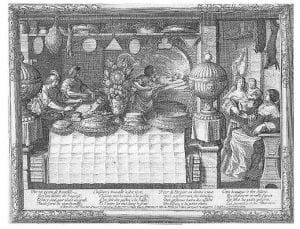 It isn’t possible to look at photographs of 17th century France, but the closest we can come are the engravings of Abraham Bosse (1604-76). He was a master engraver of all sorts of subjects, including portraiture. For us, the most interesting will probably be his scenes of ordinary life, with particular emphasis on the depictions of the poor. He showed artisans at work, too, [see the engraving on the bakery below] and his scenes of schoolrooms—one for boys, another for girls—are nearly photographic.
It isn’t possible to look at photographs of 17th century France, but the closest we can come are the engravings of Abraham Bosse (1604-76). He was a master engraver of all sorts of subjects, including portraiture. For us, the most interesting will probably be his scenes of ordinary life, with particular emphasis on the depictions of the poor. He showed artisans at work, too, [see the engraving on the bakery below] and his scenes of schoolrooms—one for boys, another for girls—are nearly photographic.
His scenes of the Corporal Works of Mercy include the often-reproduced view of wealthy pious persons visiting a prison. The prisoner with a wide metal collar around his neck attached by a chain to the wall is astonishing. So is the scene of a wife beating her husband with a ring of heavy keys. At one side of the same engraving a young girl also is striking a boy, certainly in imitation of the family scene being enacted, and at the other side, a hen is pecking fiercely on a rooster. Bosse must have had a sense of humor.
He engraved another series of single individuals, showing off the details of their clothing. This is certainly as good as this gets.


If you ever wondered what kind of world Monsieur Vincent lived in, one access point is offered by these marvelous engravings. Bosse left more than 1,600 of them.
The Vincentian collection at DePaul recently purchased the book, whose cover is shown here. It is the catalogue of an exhibition dating from 2004.
It would be interesting to know more about his works.
There were, of course, other engravers and painters in his period, but many of them date from the time of Louis XIV. In this case, they represent the styles in vogue at least at the beginning of his reign. With Bosse, we are mainly shown the styles of Louis XIII and his wife, Anne of Austria, who became regent for Louis XIV until his formal accession to the throne in 1661.
